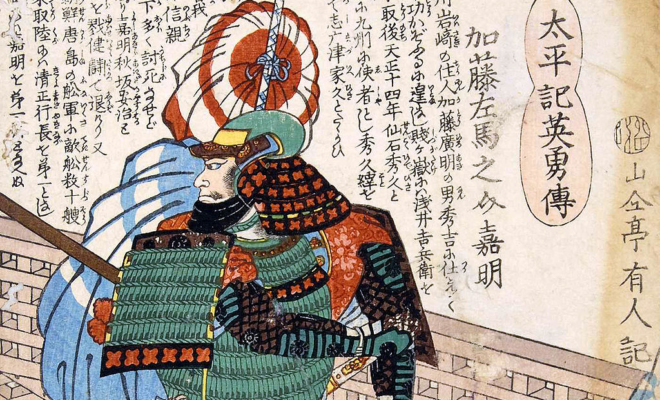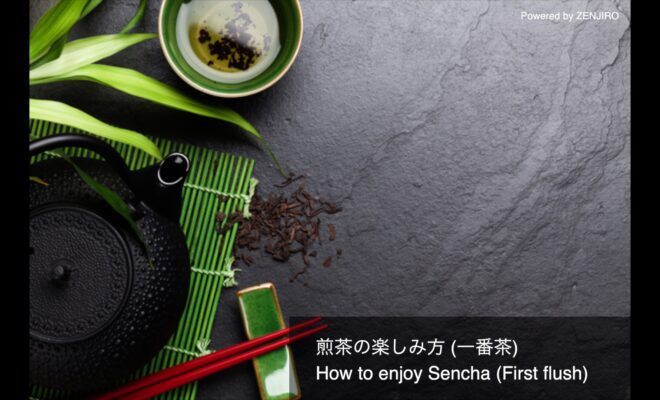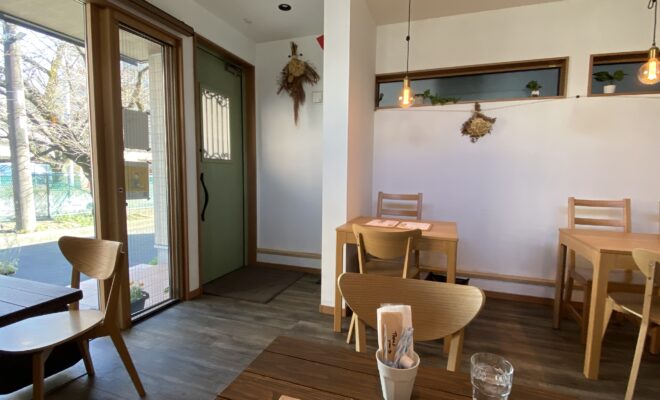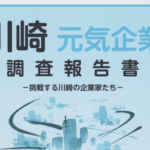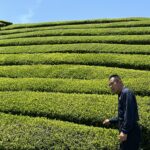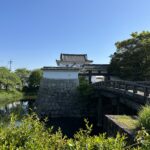Teikan-no-ma was the seat of the Kato family when they visited Edo Castle. This is the seat of Fudai daimyo who had served the Tokugawa clan since before the establishment of the shogunate, and is qualified to take an important position in the shogunate. The Kato family was actually a vassal of the Toyotomi family, but they were treated as Fudai and received the warm treatment of the sheet.
Strangely enough, the Kato family was on the verge of collapse due to the Aizu riot, but before that, they served as the lord of the Iyo-Matsuyama domain and then the Aizu domain. These correspond to the highest seats given to vassals in Tammari-no-ma (Kuroshoin Tammari-no-ma), one rank higher. In addition, there are the Hisamatsu-Matsudaira family of the Kuwana domain and the Honda family of the Okazaki domain, where Heihachiro Honda, a prestigious family since Tadakatsu Honda, established a domain. Why was Yoshiaki Kato treated so well? Omi-Mizuguchi Castle, which was given after the Aizu riot was released, is a small domain with an income of 20,000 koku, but it is a high-class castle where the shogun stays on the day before he goes to Kyoto.
This is just my guess, but I think it was influenced by Kato Yoshiaki’s father, Kato Noriaki. Kato Noriaki served two generations of Tokugawa Ieyasu’s father, Matsudaira Hirotada and Motoyasu (Ieyasu). Therefore, Odai, the lawful wife of Hirotada and the mother of Ieyasu, must have known him well. After that, Odai divorced her and she married Hisamatsu Toshikatsu, starting the Hisamatsu-Matsudaira family. In other words, Kato Yoshiaki’s father, Noriaki, had a connection with him before Ieyasu was born. In the later Mikawa Ikko Ikki, Noriaki joins the uprising. Honda Masanobu, Watanabe Moritsuna, etc. are also the same. There are others like Honda Masanobu, who was later pardoned and became a senior vassal of the Tokugawa Shogunate. Noriaki did not return to the Tokugawa family and served Shogun Yoshiaki Ashikaga, and then Hideyoshi Hashiba. In other words, the former Mikawa vassals who became senior vassals of the Toyotomi side is only Kato Yoshiaki.
I will write my new theory here. It is “Igagoe Pass” which is counted as one of Tokugawa Ieyasu’s three major crises. Tokugawa Ieyasu, who was sightseeing in Sakai with a small group before meeting with Oda Nobunaga to receive a favor, learned of the Honnoji Incident and hurriedly escaped to Mikawa, even crossing the dangerous Iga crossing. why did he run away I don’t know if it’s because Hashiba Hideyoshi is aiming for the head of Ieyasu, who was a political enemy, when he subjugated Akechi Mitsuhide with a large army in the Great Return of Chugoku, or because Mitsuhide’s army is aiming. Either way, he knew he was in danger. At this crossing of Iga, there is a figure of Honda Masanobu who returned to Ieyasu’s vassal just before (there is also a theory that he was not there).
I think it was Kato Yoshiaki’s father, Noriaki, who told Honda Masanobu of the possibility of returning from Chugoku. Noriaki served Hashiba Hidenaga, so he should have been able to know how Hidenaga was commanding the Harima area. On June 2nd, the Honnoji Incident occurred, and on the 3rd, Hideyoshi and Shibata Katsuie were notified. The return from Chugoku will start from the 4th, but of course they need to prepare for the return trip, so preparations should have started on the 3rd. At that point, I think Kato Noriaki told Honda Masanobu. Tokugawa Ieyasu, who was staying in Omi Shigaraki as a refugee, may have decided to cross Iga after hearing information from Honda Masanobu. After this, the relationship of trust between Honda Masanobu and Ieyasu became stronger and solidified the foundation of the early Tokugawa Shogunate. kato Noriaki and Honda Masanobu have in common that they both participated in the Mikawa Ikko Ikki and fought against Ieyasu. What they have in common is that they became involved with the Ashikaga family in Kyoto after being expelled from Mikawa. At this time, it would not be surprising if the two former colleagues were interacting with each other. Kato Noriaki feels indebted to Toyoyomi Hideyoshi and Hidenaga, who recruited him from the ronin. However, if the former lord’s life is in danger, it wouldn’t be surprising if the information leaked. If Ieyasu knew this truth, he could understand why the Kato family, a small domain in Omi-Minakuchi, received such a warm welcome.
Matsuyama Castle is an important military base that protects against foreign feudal lords such as the Mori clan of Choshu and the Shimazu clan of Satsuma. By the time of Akinari, the son of Kato Yoshiaki, the main gate was rebuilt from facing east to facing north, and facilities to prevent intrusions, Kita-demaru and Nishi-demaru, were created. The Kita-demaru is also known as the annihilation square.
Both domains were ultimately ruled by the Matsudaira clan, but this hypothesis makes it possible to understand the significance of the Kato clan being entrusted with such an important military base.
Kato Yoshiaki made a powerful contribution to the attack on Odawara and the dispatch of troops to Korea, but after the death of Toyotomi Hideyoshi, I think that he probably kept in close contact with Tokugawa Ieyasu. And it may be that Odai, who lived until after Sekigahara big war, played an important role in that. Odai no Kata strongly opposed the idea that his son Matsudaira Sadakatsu (the lord of the Kuwana domain of Ise) would be adopted by Hashiba Hideyoshi after the Battle of Komaki and Nagakute, and forced Ieyasu to abandon the idea. I believe that this strong relationship is the solution to the mystery of the courtesy of Edo Castle.
By the way, it seems that Kato Yoshiaki trusted the second generation Kuroda Kyubei Naotsugu. The Kuroda family was originally a branch family of the Kyogoku family, which was originally a branch of the Uda-Genji Sasaki clan. Munemitsu, the second son of Kyogoku Mitsunobu, who was the governor of northern Omi, lived in Kuroda Village in Omi Province and called himself Kuroda Hangan. The Kyogoku clan was banished from Kita-Omi due to Asai’s subjugation, and the Kuroda clan was likewise a ronin. Under such circumstances, Asai Nagamasa was overthrown by the Oda army, and Hashiba Hideyoshi built Nagahama Castle near the ruins of Odari Castle owned by the Asai clan. When he become a daimyo family, he will increase the number of vassals, and not only soldiers but also clerical work will increase. The first Kuroda Kyubei Tadatsugu was recruited by Hashiba Hideyoshi and supported by his younger brother Hidenaga. The Kuroda family also served as a member of the Muromachi shogunate’s council, so they were familiar with etiquette.
They were also familiar with the weapons group Kunitomoshu, who were local gunsmiths. Since there is no record of the year of birth in the genealogy of successive Kuroda Kyubei, it is a guess based on a series of descriptions, but the first Kyubei Tadatsugu is 5 to 7 years younger than Toyotomi Hidenaga, and the second Kyubei Naotsugu is about 17 years younger. I think it was Naotsugu also initially served Dainagon Hidenaga and was employed with 150 koku income, but later served Bito Tomonobu and was thanked for his military service in the battle in Kinan against the Negoro and Saika clan in the Kishu Conquest. . After that, he will serve Yoshiaki Kato, who became a daimyo of one country and one castle at Shichi Awaji Castle. Kato Yoshiaki made a name for himself as Shizugatake Seven Spears only two years later. Kubei Naotsugu II should have been about four years younger than Kato Yoshiaki. Awaji is the base of the Awaji Navy, which protects Osaka Bay and handles logistics. For Yoshiaki, Kyubei Naotsugu, who was younger than himself, excelled in naval forces and guns, and achieved success in the Kishu Conquest, must have been a reliable subordinate not only because of his family’s knowledge of etiquette, but also as a practical practitioner.
Partly because of that, he was able to increase his territory fourfold from the time of Dainagon Hidenaga, gaining 600 koku of territory and becoming a general of guns. Then, he fought hard with Kato Yoshiaki in the conquest of Odawara and the dispatch of troops to Korea. During the Battle of Sekigahara, Mohri army did not join the Western Army and invaded Shikoku under the cover of confusion. That is the Mitsuhama Night Attack. Tsukuda Jusei and Kuroda Naotsugu, who were away, launched a night attack on the outnumbered Mori army and routed them. Faced with an enemy barricaded in Nyoraiji Temple, Naotsugu breaks through the gate with a naginata stone and rushes in single-handedly. He was shot violently by the enemy’s guns, seven shots to his fan and wooden joints, and five shots to his body, and he died on September 19th. In October, when Kato Yoshiaki visited the battlefield of Nyoraiji Temple, Naotsugu’s younger brother Matsu, who accompanied him, gave him a precious word, and he was ordered to inherit the family headship, and he was appointed as a chigyochi territory and an attendant.
According to the city of Matsuyama, most of the literature from the era of Kato Yoshiaki was destroyed in a fire. I was hoping that I could get some new information about Kuroda Kyubei, but it’s a bit disappointing. However, it is a very good place, so I would like to visit again someday.
Postscript
I have a question, “Why did Kyubei Naotsugu recklessly rush in?” Kyubei Naotsugu had participated in notable battles, but he was primarily a navy and artillery commander who transports military supplies and soldiers. He was never the type of warrior who could single-handedly mow down an opponent.
Two hypotheses are possible. One reason was that the chief retainer from Mikawa, Tsukuda Kazunari, who was defending with him, couldn’t move. Tsukuda Kazunari was born in 1553, so he was about the same age as Naotsugu’s father, Kuroda Tadatsugu. Did he take care of Tukuda’s old body? According to the Kato family’s later compiled materials, “Meiko Hiroku Kon,” Tsukuda Kazunari was the general and Kyubei Naotsugu was the shingari finalist at the time of the night raid on Mitsuhama.
Also, at Nyorai-ji Temple, Kyubei Naotsugu and Tsukuda Kazunari attacked as both generals. It is said that Kyubei died in battle and Tsukuda was injured. Tsukuda may have been injured at Mitsuhama the day before. Kyubei, who was a general of guns, should have surrounded Nyoraiji Temple with a gun corps, but there must have been urgent circumstances. The possibility may have been the movement of Ebara Castle, the remnants of the former Kono family, who were rebelling at the same time. Ebara Castle, located south of Kume Nyoraiji Temple, is only 6km away. If you hurry on foot, it takes about only an hour. Maybe they didn’t have time to prepare.
The other is the memory of Bito Tomonori, which may have been in Kubei Naotsugu’s mind. Bito was said to be one of Hideyoshi’s four kings in the early days, and was a force to be reckoned with. Before Yoshiaki Kato, Naotsugu Kyubei fought the Kishu attack under Bito for a short period of time. In 1587, however, Bito opposed Toyotomi Hidenaga, who was thinking of recruiting addtional allied troops for the conquest of Kyushu. In the meantime, Todo Takatora rescued them with a small force and won. Hideyoshi was enraged at Bito, who advocated caution, and confiscated his territory and banished him. This memory might have crossed Naotsugu’s mind, and Todo Takatora in Imabari (neighboring territory) was a rival of Kato Yoshiaki. I have no way of knowing what the decision was at the time, but it makes me think there is such a possibility.
